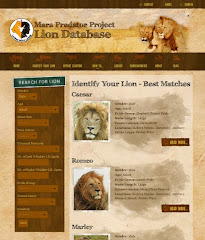For the past two weeks I’ve been in Laikpia with Living With Lions’ Laikipia Predator Project. I’ve been showing local lodges how to help by identifying lions and recording sightings in a similar way to our Mara project. Since 1997, the Laikipia Predator Project has helped conserve large carnivores by improving livestock practices, studying the behaviour and ecology of predators that live alongside humans, and monitoring their response to conservation action.
Alayne Cotterill and Steven Ekwanga use some funky equipment to study lions in a challenging landscape. Laikipia lions are shy and elusive, and so radio collars are used to follow their movements. Whilst VHF collars allow one to physically track a lion by following a signal, GPS collars are all the rage, allowing for a lion’s movements to be continuously recorded. You can read more about collars here, and follow some of our GPS collared lions in the Chyulu Hills here.
Alayne has a collared lion in every group, which allows her to track most of the lions in the vast area of Laikipia. We wanted to change one lion’s collar from a VHF to a GPS collar, a process that involved bating and darting the lion.
Contrary to popular belief, collaring is neither a risk to the lion’s health or a bother to its everyday life. Lethal overdoses are impossible with the specific drugs used, and the lions show no reaction to the collar upon waking. Collars have been widely studied for their influence on animals, and all evidence shows that hunting, socialising and all other behaviours are not affected in any way. In fact, collared lions are less likely to be killed.
We found our lion, LF167, with her pride-mate and several sub-adults by using the VHF tracker. In order to change the collar, we needed to dart the lion to put it to sleep. With a cow carcass in tow and a recording of a baby buffalo in distress, we tried to call the lions out into a safe area for darting. It is important that the lion does not go down in thick bush to avoid distress, and unfortunately the lions we playing hard to get! We left the lions at dusk, and by the time we returned the next day, they were long gone.
The information that Alayne gets from her collared lions is vital in studying their movements. Her data is showing that lions avoid communal areas with lots of people, and prefer wild game over livestock.
I’m back in the Mara now and looking forward to catching up with the locals. Silver and Lilly may have had their cubs by now, and so it’s time for a scout!
Sara
Alayne Cotterill and Steven Ekwanga use some funky equipment to study lions in a challenging landscape. Laikipia lions are shy and elusive, and so radio collars are used to follow their movements. Whilst VHF collars allow one to physically track a lion by following a signal, GPS collars are all the rage, allowing for a lion’s movements to be continuously recorded. You can read more about collars here, and follow some of our GPS collared lions in the Chyulu Hills here.
Alayne has a collared lion in every group, which allows her to track most of the lions in the vast area of Laikipia. We wanted to change one lion’s collar from a VHF to a GPS collar, a process that involved bating and darting the lion.
Contrary to popular belief, collaring is neither a risk to the lion’s health or a bother to its everyday life. Lethal overdoses are impossible with the specific drugs used, and the lions show no reaction to the collar upon waking. Collars have been widely studied for their influence on animals, and all evidence shows that hunting, socialising and all other behaviours are not affected in any way. In fact, collared lions are less likely to be killed.
We found our lion, LF167, with her pride-mate and several sub-adults by using the VHF tracker. In order to change the collar, we needed to dart the lion to put it to sleep. With a cow carcass in tow and a recording of a baby buffalo in distress, we tried to call the lions out into a safe area for darting. It is important that the lion does not go down in thick bush to avoid distress, and unfortunately the lions we playing hard to get! We left the lions at dusk, and by the time we returned the next day, they were long gone.
The information that Alayne gets from her collared lions is vital in studying their movements. Her data is showing that lions avoid communal areas with lots of people, and prefer wild game over livestock.
I’m back in the Mara now and looking forward to catching up with the locals. Silver and Lilly may have had their cubs by now, and so it’s time for a scout!
Sara






